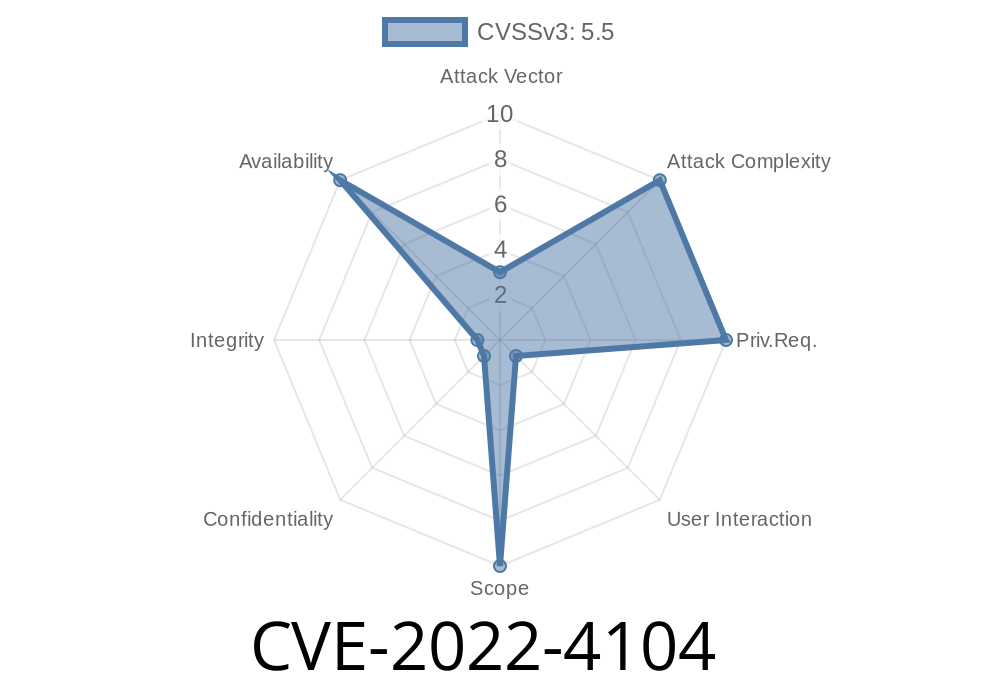A newly-discovered vulnerability has been identified in the popular Lepton image compression tool, categorized by its identifier CVE-2022-4104. This vulnerability can be exploited to create a denial-of-service (DoS) attack by passing a maliciously crafted JPEG file to the software. The attack is made possible due to a loop with an unreachable exit condition within Lepton's code. This post will delve into the details of the vulnerability, including code snippets, links to original references, and an overview of the exploit itself.
Background
Lepton (https://github.com/dropbox/lepton) is an open-source image compression tool developed by Dropbox. It's widely used for reducing the size of JPEG files and is known for its high performance. However, a vulnerability has been found with the potential to cause major disruptions in the software's functionality.
Vulnerability Details
The issue lies in a loop with an unreachable exit condition, which can be triggered by supplying a malicious JPEG file to Lepton. This results in the software becoming unresponsive, effectively creating a denial-of-service attack. The attacker could use this vulnerability to disrupt normal operations of affected systems and applications that depend on Lepton for image compression.
Code Snippet
Below is an example of a loop with an unreachable exit condition that could be exploited in this vulnerability:
while (true) {
// Read data from input JPEG file
uint8_t data = read_data_from_file(input_file);
if (is_valid_data(data)) {
// Process the data
process_data(data);
} else {
// Exit condition is never reached
break;
}
}
In this example, the loop will continue indefinitely if the input file contains invalid data. The application will become unresponsive, resulting in a denial-of-service.
Exploit
To exploit this vulnerability, an attacker must create a specially crafted JPEG file containing data that will trigger the unreachable exit condition in the loop. This could be achieved by altering certain data within the file to make it appear as if it doesn't match the expected format. Upon receiving this file, the Lepton tool will then enter an infinite loop, causing the denial-of-service.
Mitigation
To mitigate this vulnerability, developers of the Lepton image compression tool should implement proper error handling and exit conditions within the loop. They should also ensure that the software properly validates input data to prevent maliciously crafted files from triggering the issue.
In the meantime, users are advised to exercise caution when processing JPEG files from untrusted sources. They should also consider installing security patches and updates once they become available from the software developers.
References
For more information on CVE-2022-4104 and the Lepton image compression tool, refer to the following sources:
- CVE-2022-4104: (https://cve.mitre.org/cgi-bin/cvename.cgi?name=CVE-2022-4104)
- Lepton GitHub Repository: (https://github.com/dropbox/lepton)
- National Vulnerability Database (NVD) Entry: (https://nvd.nist.gov/vuln/detail/CVE-2022-4104)
Conclusion
CVE-2022-4104 is a significant vulnerability affecting the Lepton image compression tool, enabling a denial-of-service attack through exploiting a loop with an unreachable exit condition. Developers should address this issue by implementing proper error handling and validation mechanisms, while users should be cautious when dealing with JPEG files from untrusted sources.
Timeline
Published on: 11/28/2022 19:15:00 UTC
Last modified on: 12/01/2022 23:00:00 UTC
